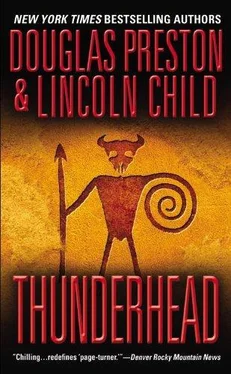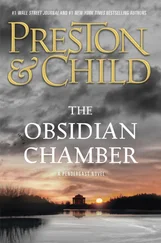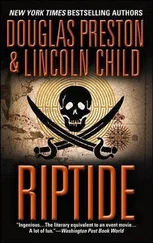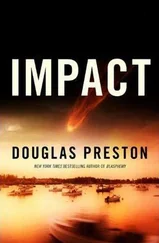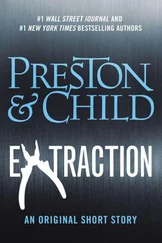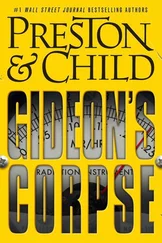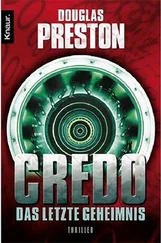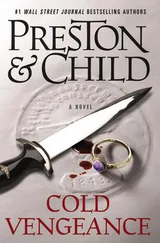Nora handed him her canteen, and he drank deeply. “That man is a sadist,” he said, wiping his mouth. “I’d have been better off building the pyramids. I want a transfer.”
“When you signed on, you knew you were going to be a digger,” Nora said, retrieving the canteen. “What better way to get your hands dirty, literally and figuratively? Besides, I’ll bet it isn’t the first time you’ve done some muckraking.”
“Et tu, Brute?” Smithback sighed.
“Come and see what we’ve done,” said Black, guiding Nora to a small, precise cut in the side of the mound.
“This is the control pit?” Nora asked.
“Yes,” Black nodded. “Beautiful soil profile, don’t you think?”
“Perfection,” Nora replied. She’d never seen such neat work or such potentially rich results. She could see where the two men had cut through the midden, exposing dozens of thin layers of brown, gray, and black soil, revealing how the trash mound had grown over time. The stratified layers had each been labeled with tiny, numbered flags, and even smaller flags marked spots where artifacts had been removed. On the ground beside the cut were dozens of Baggies and glass tubes, carefully aligned, each with its own artifact, seed, bone, or lump of charcoal. Nearby, Nora could see that Black had set up a portable water flotation lab and stereozoom microscope for separating pollen, small seeds, and human hair from the detritus. Next to it was a small paper chromatography setup for analyzing solubles. It was a highly professional job, executed with remarkable assurance and speed.
“It’s a textbook sequence,” said Black. “At the top is Pueblo III, where we see corrugated and some red ware. Under that is Pueblo II. The sequence begins abruptly at about A.D. 950.”
“The same time the Anasazi started building Chaco Canyon,” Nora said.
“Correct. Below this layer”—he pointed to a layer of light brown dirt—“is sterile soil.”
“Meaning the city was built all at once,” Nora said.
“Exactly. And take a look at this.” Black opened a Ziploc bag and gently slid three potsherds onto a nearby piece of felt. They glinted dully in the noon sun.
Nora drew in her breath sharply. “Black-on-yellow micaceous,” she murmured. “How beautiful.”
Black raised an eyebrow. “The rarest of the rare. So you’ve seen the type before?”
“Once, on my Rio Puerco dig. It was very weathered, of course; nobody’s ever found an intact pot.” It was a testament to the richness of the site that Black had found three such sherds in just one day’s digging.
“I’d never actually seen a piece before,” Black said. “It’s amazing stuff. Has anybody ever dated it?”
“No. Only two dozen sherds have ever been found, and they’ve all been too isolated. Maybe you’ll find enough here for the job.”
“Maybe,” Black replied, returning the fragments to the plastic bag with rubber-tipped tweezers. “Now look at this.” He squatted beside the soil profile and pointed his trowel tip at a series of alternating dark and light bands. Each was littered with distinct layers of broken pottery. “There was definitely a seasonal occupation of the site. For most of the year, there were not many people in residence, I’d guess fifty or less. And then there was a large influx every summer; obviously a seasonal pilgrimage, but on a far vaster scale than at Chaco. You can tell by the volume of broken pots and hearth ashes.”
A seasonal pilgrimage, Nora thought. Sounds like Aragon’s ritual journey to a city of priests. She decided not to antagonize Black by saying this aloud. “How can you tell it was summertime?” she asked instead.
“Pollen counts,” Black sniffed. “But there’s more. As I said, we’ve only started the test trench. But already it’s clear that the trash mound was segregated.”
Nora stared at him curiously. “Segregated?”
“Yes. In the back part of the mound there are fragments of beautiful painted pottery and the bones of animals used for food. Turkeys, deer, elk, bear. There are a lot of beads, whole arrowheads, even chipped pots. But in the front we find only the crudest, ugliest corrugated pottery. And the food we found in the front of the mound was clearly different.”
“What kinds of foods?”
“Mostly rats,” said Black. “Squirrels, snakes, a coyote or two. The flotation lab has brought up a lot of crushed insect carapaces and parts as well. Cockroaches, grasshoppers, crickets. I did a brief microscopic examination, and most of them seem to have been lightly toasted.”
“They were eating insects?” Nora asked incredulously.
“Without a doubt.”
“I prefer my bugs al dente, ” said Smithback, with an unpleasant smacking of his lips.
Nora looked at Black. “What’s your interpretation of this?”
“Well, there’s never been anything like it in Anasazi sites. But in other sites, this kind of thing points directly to slavery. The masters and slaves ate different things and dumped their trash in different places.”
“Aaron, there isn’t a shred of evidence that the Anasazi had slaves.”
Black looked back at her. “There is now. Either slavery, or we’re looking at a deeply stratified society: a priestly class that lived in high luxury, and an underclass living in abject poverty, with no middle class in between.”
Nora glanced around the city, quiet in the noonday sun. The discovery seemed to violate all that they knew about the Anasazi. “Let’s keep an open mind until all the evidence is in,” she said at last.
“Naturally. We’re also collecting carbonized seeds for C-fourteen dating and human hair for DNA analysis.”
“Seeds,” Nora repeated. “By the way, did you know that most of those granaries in the rear of the city are still bulging with corn and beans?”
Black straightened up. “No I didn’t.”
“Sloane told me earlier this morning. That suggests the site was abandoned in the fall, at harvest time. And that it was abandoned very quickly.”
“Sloane,” Black repeated casually. “She came by here a little earlier. Where is she now, anyway?”
Nora, who’d been looking away, looked back. “Somewhere in the central roomblocks, I think. She’s beginning the preliminary survey, with the help of Peter and his magnetometer. I’ll be checking in with her later. But now I’m off to see what Aragon is up to.”
Black seemed to be thinking about something. Then he turned and laid a hand on Smithback’s shoulder. “Care to finish up F-one, my muckraking friend?”
“Slavery still exists,” Smithback muttered.
She raised her radio to her lips. “Enrique, this is Nora. Do you read?”
“Loud and clear,” came the answer after a moment of silence.
“Where are you?”
“In the crawlspace behind the granaries.”
“What are you doing back there?”
There was a short silence. “Better see for yourself. Come in from the west side.”
Nora walked around the back of the midden heap and past the first great tower. Typical cautious Aragon, she thought; why couldn’t the man simply come out and say what was up?
Just beyond the tower she picked up the small passageway that ran behind the granaries toward the back of the cave. It was dark and cool here behind the ruin, and the air smelled of sandstone and smoke. The passageway doglegged through a gap in the granaries, and there she came to a sunken passage—Aragon’s Crawlspace—at the very rear of the city. Once again, the Crawlspace was a feature unique to Quivira. As Nora moved forward, the ceiling of the passageway became so low that she had to drop to her hands and knees. There was a long moment of close, oppressive darkness, then ahead she could see the glow from Aragon’s lantern.
Читать дальше
